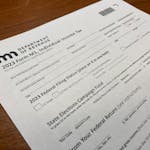Xcel Energy was cleared of criminal liability in a 2021 Colorado wildfire fanned by high winds that destroyed nearly 1,100 homes and left two people dead.
Embers from a smoldering scrap wood fire set days earlier outside a home used by the Twelve Tribes Christian religious communal group, along with a sparking Xcel power line, caused the fire, authorities said Thursday.
Authorities spent 18 months investigating and determined criminal charges were not warranted for either Xcel or the Twelve Tribes, Boulder County (Colo.) District Attorney Michael Dougherty said at a news conference.
The Dec. 30, 2021, blaze in heavily populated suburbs between Denver and Boulder caused $2 billion in damage, making it the most destructive in Colorado history. Two people were also found dead after what was known as the Marshall Fire.
A lawsuit filed against Minneapolis-based Xcel, which is Colorado's largest utility, alleged that sparks from a power line started the blaze. It says witnesses saw a fire igniting near a power line in the area identified by investigators, with one witness videoing sparks flying from a malfunctioning power line and igniting a fire on the ground.
The Colorado investigation did conclude that a loose Xcel Energy power line caused one fire less than a half a mile from the main blaze, Johnson said.
In a statement, Xcel said "we strongly disagree with any suggestion that Xcel Energy's powerlines caused the second ignition. ... Xcel Energy did not have the opportunity to review and comment on the analyses relied on by the Sheriff's Office and believes those analyses are flawed and their conclusions are incorrect. We have reviewed our maintenance records and believe the system was properly maintained."
The inferno erupted following months of drought amid a winter nearly devoid of snow and fed on bone-dry grassland surrounding fast-growing development in the area near the Rocky Mountain foothills. It spread rapidly in winds that gusted up to 100 mph in places.
The scrap wood fire — buried by Twelve Tribes residents Dec. 24 and OK'd by firefighters who stopped by that day to investigate — spread when the powerful winds uncovered the buried embers six days later, Sheriff Curtis Johnson said at the news conference.
The investigation found that the two fires combined because of the powerful winds to cause the massively destructive blaze.
Experts say similar events will become more common as climate change warms the planet and suburbs grow in fire-prone areas.
The fire that destroyed swaths of houses in the cities of Superior and Louisville, neighboring towns about 20 miles northwest of Denver, is blamed for the death of a 69-year-old man who lived near where investigators believed the fire started. The remains of a 91-year-old woman, who was last seen trying to rescue her dogs from her home in Superior, were also found.
Thousands of residents were at home the day before New Year's Eve and used the suburban area's extensive road network to escape amid smoke, flames and blowing embers, which spread the fire in the wind. Shifting winds caused the skies to turn from clear to smoky and then back again in an area filled with middle and upper-middle class subdivisions surrounded by shopping centers, parks and schools.
As smoke filled the parking lot of a Costco warehouse store and debris whirled around, a sheriff's deputy ordered people inside to leave their carts, evacuate the sprawling building and head toward Denver, away from the fire. Within hours, it destroyed 1,084 homes and seven commercial buildings, and damaged nearly 200 structures.
Experts say similar events will become more common as climate change warms the planet and suburbs grow in fire-prone areas.
The fire, which spanned 9.4 square miles, ranks as the most destructive in state history in terms of homes and other structures destroyed and damaged. The second-most destructive fire erupted in 2013 outside Colorado Springs, destroying 489 homes and killing two.
Star Tribune staff writer Mike Hughlett contributed to this report.




